Hinduism in Queens
Hinduism & Indian Culture In Queens
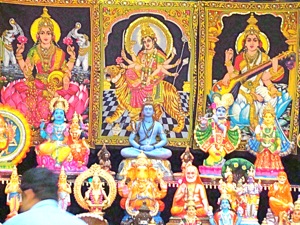 Continued / Flushing / Queens Buzz. Indian civilization dates back to prehistoric times and the Hindu religion is believed to be the oldest continuous religious culture in existence to day. In fact it is not known how long the oral tradition, of passing down important texts from generation to generation existed, prior to recording the information in written form. The written form of the Vedas, one of the cornerstones of Hinduism, first appeared between 3,000 and 4,000 years ago.
Continued / Flushing / Queens Buzz. Indian civilization dates back to prehistoric times and the Hindu religion is believed to be the oldest continuous religious culture in existence to day. In fact it is not known how long the oral tradition, of passing down important texts from generation to generation existed, prior to recording the information in written form. The written form of the Vedas, one of the cornerstones of Hinduism, first appeared between 3,000 and 4,000 years ago.
Indian art and iconography are imaginative, colorful and legendary. In the photo to the right is an altar featuring a number of deities from the Hindu pantheon.
Ganesha Temple In Flushing Queens
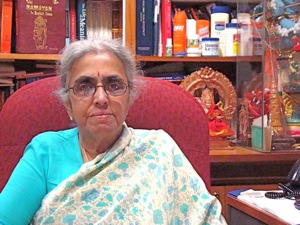 I walked through the temple and out the back exit to meet Dr. Uma Mysorekar, president of the Ganesha Temple. Dr. Mysorekar had arrived in America with her parents as a young woman in 1969.
I walked through the temple and out the back exit to meet Dr. Uma Mysorekar, president of the Ganesha Temple. Dr. Mysorekar had arrived in America with her parents as a young woman in 1969.
Uma was studying medicine when she and her family arrived in Flushing in 1972. She finished her residency at LIJ and for the next thirty years Dr. Mysorekar practiced medicine in the NYC metro area. Her involvement in the Ganesh Temple also began more than two decades ago. Dr. Mysorekar is shown in the photo to the left.
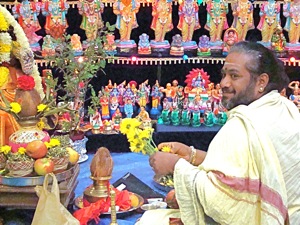 Indian Swamis In America 1893
Indian Swamis In America 1893
In 1893 Swami Vivekananda became the first Hindu monk to visit the U.S. during the World’s Parliament of Religions in Chicago. There were efforts to establish Hindu Temples in America in the early 20th century, but Hinduism was generally perceived as a cult in America, and hence was generally practiced in the privacy of individual homes until later in the 20th century. We were told that the Ganesh Temple in Flushing was the first Hindu Temple to open publicly in America. In the photo to your right is a Hindu priest offering prayers before the Navaritri decoration at the Ganesh Temple in Flushing.
 Indian Culture In America
Indian Culture In America
In the 1960’s and 1970’s Indian culture came into vogue due in part because of trips to India by rock bands such as the Beatles. Influences of Indian music were also apparent in The Doors albums and the influence of Indian art can be seen in the colorful iconography that began to appear on record album covers. The photo to your left is the Beatles album cover for Sargeant Peppers Lonely Hearts, which was designed to bear some similarity to a Hindu shrine.
Hare Krishna Is An American - Not Hindu - Organization
 The Hare Krishna movement began in the U.S. beginning in 1965 under the direction of Swami Prabhupada. While the swami was raised in India, and Hare Krishna is based in part on Hinduism, this group was a totally new religious sect, created in America and with its own interpretation of Hindu texts.
The Hare Krishna movement began in the U.S. beginning in 1965 under the direction of Swami Prabhupada. While the swami was raised in India, and Hare Krishna is based in part on Hinduism, this group was a totally new religious sect, created in America and with its own interpretation of Hindu texts.
Unlike traditional Hinduism which doesn’t have a proselytizing element to it, Hare Krishnas starting handing out literature and seeking new converts in neighborhoods, airports and other public places in America. The images of Hare Krishna missionaries continue to influence the American perception of Hinduism to this day. Krishna is just one of the Hindu deities. In the photo to your right is the long entrance hallway leading from Holly Avenue into the Ganesh Hindu Temple in Flushing which we mentioned in the introduction to this report.
Ganesh Temple In Flushing Queens
The Ganesh Temple in Flushing started in 1972 when a small group of Hindu devotees bought the building from a Russian church, which had decided to move. In doing so this  temple is believed to be the first public Hindu Temple in America. As mentioned previoiusly, while Hindus had held religious services in the U.S. prior to this time, it was generally done so in the privacy of someone’s home. The S.V. Temple in Pittsburgh opened within weeks following the opening of the Ganesh Temple in Flushing.
temple is believed to be the first public Hindu Temple in America. As mentioned previoiusly, while Hindus had held religious services in the U.S. prior to this time, it was generally done so in the privacy of someone’s home. The S.V. Temple in Pittsburgh opened within weeks following the opening of the Ganesh Temple in Flushing.
It took five years to refurbish the building using the scant resources available in the community at the time. Nonetheless, with patience they persevered and finally opened the temple in 1977. Today the Ganesh Temple has grown to be a community complex which includes offices, a senior center, and a community center that has an auditorium, classrooms and two wedding halls. And of course there's the Ganesh Temple which will soon complete a major renovation. The Ganesh Temple of Flushing is shown in the photo to your left while it was still under construction.
Indians Neighborhoods In Queens – Jackson Heights, Flushing & Jamaica
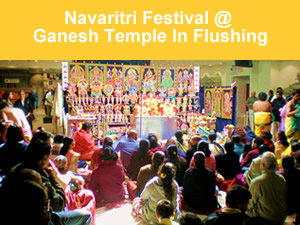 The Hindu community of Ganesh Temple encompasses some 22,000 devotees, which by any measure is most impressive. In addition to providing a place of worship, the temple offers classes on Indian and Hindu culture as well as mathematics, various academic subjects and SAT preparations. I was told that many members of the community eventually go on to college at Ivy League schools. There are currently about 180 to 200 students attending the classes. The photo to your right shows the Navaritri Festival decoration at Ganesh Hindu Temple in Flushing
The Hindu community of Ganesh Temple encompasses some 22,000 devotees, which by any measure is most impressive. In addition to providing a place of worship, the temple offers classes on Indian and Hindu culture as well as mathematics, various academic subjects and SAT preparations. I was told that many members of the community eventually go on to college at Ivy League schools. There are currently about 180 to 200 students attending the classes. The photo to your right shows the Navaritri Festival decoration at Ganesh Hindu Temple in Flushing 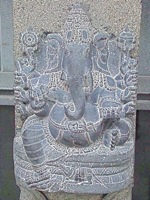 in Queens.
in Queens.
Hours Of Ganesh Temple In Flushing
Hindu worship appears less structured than what we’re accustomed to in the west. The temple remains open from 8 am to 9 pm and people come and go as they please. There are regular services, just as in western religions, and they tend to be concentrated during the weekends. In the photo to your left is one of the 16 bas reliefs of Ganesh which are embedded in the columns along the long entrance way leading into Ganesh Temple in Flushing. Ganesh Temple is located at 45-57 Bowne Street in Flushing.
Hinduism In Queens – Ancient Texts & Philosophy
The Manusmriti – Dharma Or Correct Behaviors
 Dr. Mysorekar and I started our discussion about Hinduism with the Manusmriti. The Manusmriti is a text that had been written over two thousand years ago, but like the Vedas, is believed to have been handed down through prior oral traditions. The Manusmriti is written as a dialogue between a Brahma and students, wherein the Brahma is believed to have divine origins. The divine origins lend authority to the texts and the text provides instruction on dharma or correct behaviors.
Dr. Mysorekar and I started our discussion about Hinduism with the Manusmriti. The Manusmriti is a text that had been written over two thousand years ago, but like the Vedas, is believed to have been handed down through prior oral traditions. The Manusmriti is written as a dialogue between a Brahma and students, wherein the Brahma is believed to have divine origins. The divine origins lend authority to the texts and the text provides instruction on dharma or correct behaviors.
Dr. Mysorekar summarized the text by telling me that there is an expectation in life for everyone one of us regarding what we need to do. We all have a mission. The goal in life is to understand ourselves and in so doing realize what is our mission. Then we must fulfill that mission.
Hinduism In Queens – One God Working Through A Pantheon Of Many Deities
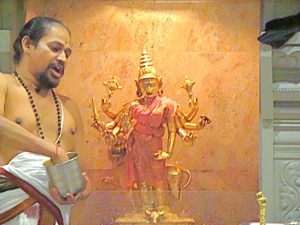 All religions have rituals. And the rituals are to reinforce correct behaviors and remind us of our mission. There is only one supreme being, which in Hinduism is Brahman, which is formless and 1) omniscient, 2) omnipresent and 3) omnipotent. Sages and seers worship god in a formless way, but icons are used to help ordinary Hindu devotees concentrate. In the photo to your left, one of the Hindu priests is making an offering to goddess Durga, goddess of energy, one of three deities [Durga, Saraswati and Lakshmi] celebrated in the Navaratri Festival.
All religions have rituals. And the rituals are to reinforce correct behaviors and remind us of our mission. There is only one supreme being, which in Hinduism is Brahman, which is formless and 1) omniscient, 2) omnipresent and 3) omnipotent. Sages and seers worship god in a formless way, but icons are used to help ordinary Hindu devotees concentrate. In the photo to your left, one of the Hindu priests is making an offering to goddess Durga, goddess of energy, one of three deities [Durga, Saraswati and Lakshmi] celebrated in the Navaratri Festival.
Hence Hinduism has a pantheon of gods, all of which have special significance with which to help one concentrate. For example, I had previously mentioned Shakti, the 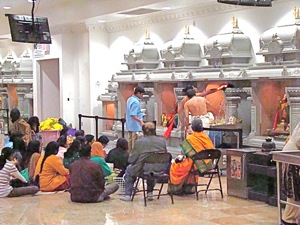 Divine Mother in connection with the fall Navaratri celebration. Durga [also called Shakti] is the goddess of power and energy. So when one needs guidance from the divine mother regarding matters of power and energy, one prays to Durga. This appears to have some similarities with praying to saints in the Christian tradition. For example one prays to St Anthony to find something or to St Gerard for a safe pregnancy. In the photo to your right are a number of altars to Hindu deities. These shrines bear some similarity to the various shrines located throughout churches in Christianity
Divine Mother in connection with the fall Navaratri celebration. Durga [also called Shakti] is the goddess of power and energy. So when one needs guidance from the divine mother regarding matters of power and energy, one prays to Durga. This appears to have some similarities with praying to saints in the Christian tradition. For example one prays to St Anthony to find something or to St Gerard for a safe pregnancy. In the photo to your right are a number of altars to Hindu deities. These shrines bear some similarity to the various shrines located throughout churches in Christianity
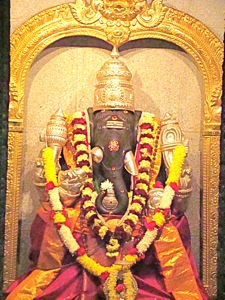 Ganesh, the elephant-headed deity to whom this temple is dedicated, is the remover of obstacles. A Hindu prays to Ganesh before they start something so that obstacles, which one is sure to encounter, can be overcome. An idol of Ganesh is shown in the photo to the left. This idol occupies the central location of a walk-in altar at the Ganesh Temple in Flushing.
Ganesh, the elephant-headed deity to whom this temple is dedicated, is the remover of obstacles. A Hindu prays to Ganesh before they start something so that obstacles, which one is sure to encounter, can be overcome. An idol of Ganesh is shown in the photo to the left. This idol occupies the central location of a walk-in altar at the Ganesh Temple in Flushing.
Ancient Origins Of Hinduism - The Vedas
As previously mentioned, the Vedas were handed down orally for generations and first written down between three and four thousand years ago. They contain hymns, recitations, poetry and chants all of which may be used in the practice of Hinduism.
Upanishads – The Philosophy Of Hinduism
Dr. Mysorekar informed me that the Hindu philosophy is recorded in the Upanishads. These were written over two thousand years ago. The Upanishads are a story where the author teaches his students the lessons of life. Two of the main principles in the Upanishad are the concept of karma [action] and dharma [righteous duty].
Karma – Do Unto Others As Have Done To Yourself
 In the Hindu religion they believe that everything you do either benefits you or harms you. Hence is you help someone, you generate good karma which will come back to you in this or a future life. Conversely, if you inflict suffering on another, it will generate bad karma, which will come back to you in this or another life. This philosophical concept corresponds with Newton’s Law – for every action there is an opposite and equal reaction, as well as with one of the great underlying principles in physics that shows that no matter or energy is ever lost – only transformed. To the right is a photo of one of the temple
In the Hindu religion they believe that everything you do either benefits you or harms you. Hence is you help someone, you generate good karma which will come back to you in this or a future life. Conversely, if you inflict suffering on another, it will generate bad karma, which will come back to you in this or another life. This philosophical concept corresponds with Newton’s Law – for every action there is an opposite and equal reaction, as well as with one of the great underlying principles in physics that shows that no matter or energy is ever lost – only transformed. To the right is a photo of one of the temple 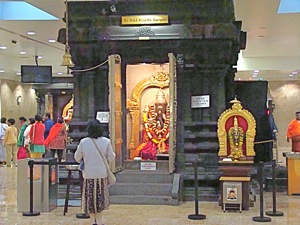 volunteers working with flowers.
volunteers working with flowers.
Dharma is the correct way to live one’s life. The Hindus believe that all living things must be treated with respect. Hence in many parts of India, Hindus do not kill nor eat cows nor elephants, nor any other living animal as well. In some parts of India Indians do eat meat. Both the cow and the elephant have special status as they are seen as ‘nurturing’ animals and both animals are vegetarian.
Bhagavad Gita – Krishna’s Story
The Bhagavad Gita is told by Krishna to a Arjuna, a warrior on the battlefield; and it incorporates and summarizes many elements contained in the Vedas and Upanishads. The Bhagavad Gita is a part of the Mahabharatha - one of the two great Hindu epics. The Bhagavad Gita is a narration about how one can attain salvation by the four paths outlined below.
Yoga & Hinduism – Indian Role & Practice
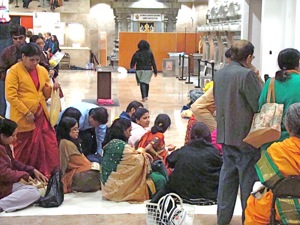 Yoga in Sanskrit means ‘union with god’. The goal of yoga is to purify oneself [one’s soul] in order to enable a more perfect union with Brahma or god: the source of all souls. There are four types of yoga or paths to god: 1) Karma Yoga which is selfless work, 2) Bhakti Yoga which is devotion or meditation, 3) Gnana Yoga which is pursuit and sharing of knowledge and 4) Raja Yoga which is community service such as building temples and schools. Any one of these paths, or in most cases, any combination of these paths will bring one closer to god.
Yoga in Sanskrit means ‘union with god’. The goal of yoga is to purify oneself [one’s soul] in order to enable a more perfect union with Brahma or god: the source of all souls. There are four types of yoga or paths to god: 1) Karma Yoga which is selfless work, 2) Bhakti Yoga which is devotion or meditation, 3) Gnana Yoga which is pursuit and sharing of knowledge and 4) Raja Yoga which is community service such as building temples and schools. Any one of these paths, or in most cases, any combination of these paths will bring one closer to god.
Health Club Yoga - American Adaptation Of Hatha Yoga
Yoga in the practice of the Hindu faith contains many spiritual dimensions to it which are not included in the practice of yoga as taught in American health clubs. Hindu yoga is about the breathing and movement of the body, which is the temple of the spirit. The goal is to bring awareness to your soul of what’s around you. The asanas or postures are designed to help make you stronger so you can complete your mission.
Chanting In Yoga – Good Vibrations Indian Style
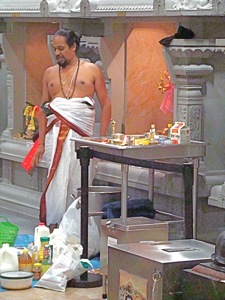 Chanting is used in Hindu yoga, in a fashion similar to singing hymns in Christianity. When one chants to a deity, it fills you with a good vibration and gives you a good feeling. The repetition is designed to help you concentrate on what you’re trying to achieve. And the entire process of chanting and concentrating are also beneficial to both body and mind. In the photo to the right is a swami conducting a service during Navaratri. The service includes chanting, which is comparable to the choruses in other faiths.
Chanting is used in Hindu yoga, in a fashion similar to singing hymns in Christianity. When one chants to a deity, it fills you with a good vibration and gives you a good feeling. The repetition is designed to help you concentrate on what you’re trying to achieve. And the entire process of chanting and concentrating are also beneficial to both body and mind. In the photo to the right is a swami conducting a service during Navaratri. The service includes chanting, which is comparable to the choruses in other faiths.
The Goal Of Hindus In Queens
Like Christianity the goal of Hinduism is to get closer to god. The Hindus believe that our souls exist in a dimension of the universe that is one with god. In thinking about this it struck me as similar in concept to the Christian purgatory, which is the dimension between heaven [at one with god] and hell.
Cremation & Souls - Hinduism In Queens
All Hindus are cremated. It is believed that once the soul leaves the body – the body has no value. After death one’s soul goes to the dimension that is close to god. Then based on the karma of the soul it is sent onto its next life. Great prophets are sent to us when we are losing the struggle against evil.
Ganesh Temple In Flushing / Hindus In Queens
 Dr. Mysorekar had to leave for another commitment. We walked back into the temple where she disappeared en-route to her next meeting. I stayed to observe the Navaratri Festival which was in its second last day. There were flowers, and small altars with deities and offerings at some of the altars.
Dr. Mysorekar had to leave for another commitment. We walked back into the temple where she disappeared en-route to her next meeting. I stayed to observe the Navaratri Festival which was in its second last day. There were flowers, and small altars with deities and offerings at some of the altars.
A couple of priests were officiating a ceremony in Sanskrit, which I didn’t understand. Others were preparing flowers which had been brought by various temple members. Everything seemed quite casual, laid back, accepting. I shot a few more photos and then headed down the long hallway to pick up my shoes.
Moments later I was teleported back into Flushing. A light warm drizzle was coming down as the sun disappeared over the horizon. Hari Om.
Site Search. 1) For best results, when typing in more than one word, use quotation marks - eg "Astoria Park". 2) Also try either singular or plural words when searching for a specific item such as "gym" or "gyms".
$element(bwcore,insert_search,N)$
Click this link to search for something in our Queens Business Directory containing over 1,000 listings.
Send this story to a friend by filling in the appropriate box below.












